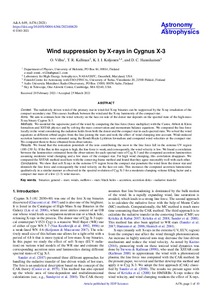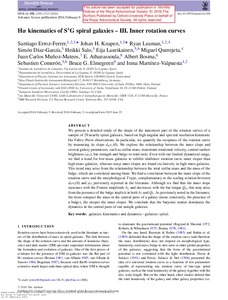Hae
Aineistot 441-447 / 447
Wind suppression by X-rays in Cygnus X-3
Context. The radiatively driven wind of the primary star in wind-fed X-ray binaries can be suppressed by the X-ray irradiation of the compact secondary star. This causes feedback between the wind and the X-ray luminosity ...
The 2020 April-June super-outburst of OJ 287 and its long-term multiwavelength light curve with Swift: binary supermassive black hole and jet activity
We report detection of a very bright X-ray-UV-optical outburst of OJ 287 in 2020 April-June, the second brightest since the beginning of our Swift multiyear monitoring in late 2015. It is shown that the outburst is ...
Type II supernovae from the Carnegie Supernova Project-I. II. Physical parameter distributions from hydrodynamical modelling
<p>Linking supernovae to their progenitors is a powerful method to further our understanding of the physical origin of their observed differences, while at the same time to test stellar evolution theory. In this second ...
Type II supernovae from the Carnegie Supernova Project-I. I. Bolometric light curves of 74 SNe II using uBgVriYJH photometry
<p>The present study is the first of a series of three papers where we characterise the type II supernovae (SNe~II) from the Carnegie Supernova Project-I to understand their diversity in terms of progenitor and explosion properties. In this first paper, we present bolometric light curves of 74 SNe~II. We outline our methodology to calculate the bolometric luminosity, which consists of the integration of the observed fluxes in numerous photometric bands (uBgVriYJH) and black-body (BB) extrapolations to account for the unobserved flux at shorter and longer wavelengths. BB fits were performed using all available broadband data except when line blanketing effects appeared. Photometric bands bluer than r that are affected by line blanketing were removed from the fit, which makes near-infrared (NIR) observations highly important to estimate reliable BB extrapolations to the infrared. BB fits without NIR data produce notably different bolometric light curves, and therefore different estimates of SN~II progenitor and explosion properties when data are modelled. We present two methods to address the absence of NIR observations: (a) colour-colour relationships from which NIR magnitudes can be estimated using optical colours, and (b) new prescriptions for bolometric corrections as a function of observed SN~II colours. Using our 74 SN~II bolometric light curves, we provide a full characterisation of their properties based on several observed parameters. We measured magnitudes at different epochs, as well as durations and decline rates of different phases of the evolution. An analysis of the light-curve parameter distributions was performed, finding a wide range and a continuous sequence of observed parameters which is consistent with previous analyses using optical light curves....</p>...
The nuclear transient AT 2017gge: a tidal disruption event in a dusty and gas-rich environment and the awakening of a dormant SMBH
We present the results from a dense multwavelength [optical/UV, near-infrared (IR), and X-ray] follow-up campaign of the nuclear transient AT 2017gge, covering a total of 1698 d from the transient's discovery. The bolometric ...






